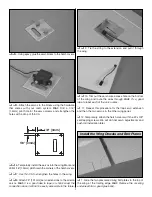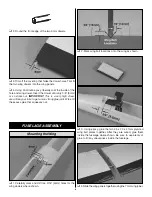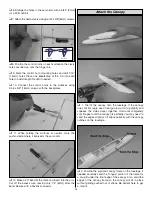
7. If you are not already an experienced R/C pilot, you
should fly the model only with the help of a competent,
experienced R/C pilot.
Remember: Take your time and follow the instructions to
end up with a well-built model that is straight and true.
If you have not flown this type of model before, we
recommend that you get the assistance of an experienced
pilot in your R/C club for your first flights. If you're not a
member of a club, your local hobby shop has information
about clubs in your area whose membership includes
experienced pilots.
In addition to joining an R/C club, we strongly recommend
you join the AMA (Academy of Model Aeronautics). AMA
membership is required to fly at AMA sanctioned clubs. There
are over 2,500 AMA chartered clubs across the country.
Among other benefits, the AMA provides insurance to its
members who fly at sanctioned sites and events. Additionally,
training programs and instructors are available at AMA club
sites to help you get started the right way. Contact the AMA
at the address or toll-free phone number below:
Academy of Model Aeronautics
5151 East Memorial Drive
Muncie, IN 47302-9252
Tele. (800) 435-9262
Fax (765) 741-0057
Or via the Internet at:
http://www.modelaircraft.org
❏
Radio with at least 4 channels (a minimum of a 5-channel
radio with mixing functions is required for the advanced
features)
❏
(6) mini servos (FUTM0033 S3101 servos recommended)
❏
Hi-Start or other launching device (DYFP8302)
❏
1/4" Foam Rubber Padding (HCAQ1000)
❏
(2) 24" Servo Extensions (HCAM2200)
❏
(2) 6" Servo Extentions (HCAM2000)
❏
(2) “Y” Harnesses (HCAM2500, only one required for
advanced features)
❏
(2) 12" Servo Extensions (HCAM2100, required for
advanced features only)
❏
1/2 oz. Thin Pro CA (GPMR6001)
❏
1/2 oz. Medium Pro CA+ (GPMR6007)
❏
30-Minute Epoxy (GPMR6047)
❏
Hobby knife (HCAR0105)
❏
#11 blades (HCAR0211)
❏
Builder's triangle (HCAR0480)
❏
Electric drill and drill bits
❏
#1 Phillips screwdriver (HCAR1022)
❏
Pliers with wire cutter (HCAR0630)
Here is a list of optional tools that will help you build the
Spirit Elite ARF.
❏
Great Planes CG Machine™ (GPMR2400)
❏
Straightedge with scale (HCAR0475)
❏
Cutting mat (HCAR0456)
❏
CA Applicator tips (GPMR6033)
❏
CA Debonder (GPMR6039)
❏
CA accelerator (GPMR6034)
❏
6-Minute Epoxy (GPMR6045)
❏
Milled Fiberglass (GPMR6165)
❏
Mixing Sticks (GPMR8055)
❏
Denatured Alcohol (for epoxy clean up)
❏
Felt-Tip Marker (TOPQ2510)
❏
Rotary tool such as Dremel
❏
Sealing Iron (TOPR2100)
❏
Covering sock (TOPR2175)
❏
Great Planes AccuThrow
™
Deflection Gauge (for
measuring control throws, GPMR2405)
•
There are two types of screws used in this kit:
Sheet metal screws
are designated by a number and a
length. For example #6 x 3/4"
This is a number six screw that is 3/4" long.
Machine screws
are designated by a number, threads per
inch and a length. For example 4-40 x 3/4"
This is a number four screw that is 3/4" long with
forty threads per inch.
IMPORTANT BUILDING NOTES
Optional Supplies and Tools
Adhesives and Building Supplies
Hardware and Accessories
ADDITIONAL ITEMS REQUIRED
We, as the kit manufacturer, provide you with a top quality
kit and instructions, but ultimately the quality and flyability
of your finished model depends on how you build it;
therefore, we cannot in any way guarantee the
performance of your completed model and no
representations are expressed or implied as to the
performance or safety of your completed model.
3




































